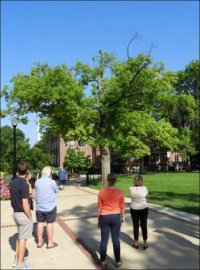AgEBB-MU CAFNR Extension
Green Horizons
Volume 23, Number 3
Fall 2019
Urban Forestry
The Francis Quadrangle Legacy Oaks Project
By Pete Millier | Director of MU Landscape Services
Planted in the mid-1950s, the pin oaks (Quercus palustris) surrounding the Francis Quadrangle are in the last stages of their natural lives. Normally, this species has a life expectancy of 70 to 90 years. However, the addition of a lawn irrigation system in the 1990's to sustain the turf grass shaved off several of those years to the point some of them were becoming hazardous to pedestrians and buildings. While over the past few years there had been ongoing discussion on eventually replacing these legacy oaks (as they had become to be called), in July of 2018, the health of five of the most severely distressed trees passed the tipping point and the trees were removed. That transformed conversation into action. The University's Landscape Services and the Mizzou Botanic Garden convened a group to advise the campus on the best way to replace these legacy oaks. This included selecting a suitable species that would honor the heart of the university longer than the relatively short-lived pin oaks.
 |
Distressed pin oak on Quad that was removed in the summer of 2018 |
Working with Wayne Lovelace, an MU Alumnus and owner of Forrest Keeling Nursery in Elsberry, Missouri, five species are currently under evaluation at the MU South Farm Research and Extension Center on the southeast edge of town. These are the swamp white oak (Quercus bicolor), overcup oak (Q. lyrata), bur oak (Q. macrocarpa), Quercus x schuettei oak (Q. macrocarpa x Q. bicolor), and Quercus x 'Jillian' (Q. bicolor x Q. macrocarpa x Q. lyrata). One of the guiding principles of the tree selection process is to plant trees that will last 100-200 years. All five species have been tested for their adaptability to Missouri climate and soils. One dozen of each of these species are being grown in 30-gallon knit bags placed in the ground. The knit bag system encourages a fibrous root system that will allow the trees to be easily transplanted with minimal transplant shock. They will be well cared for receiving optimal amounts of water and fertilizer. Of the 60 trees being evaluated at South Farm, 20 will be selected in two to three years for transplanting to the Quad. The remaining trees will serve as replacements for other overmature pin oaks across campus.
A unique challenge to this project is the infrastructure of the Quad itself. It is bordered on three sides with 100 year old utility tunnels. These tunnels are the arteries, lungs, and central nervous system of the Columbia campus providing steam, chilled water, and electricity. They make the Quad akin to a bath tub by restricting the irrigation water to freely exit the soil profile. The sidewalks above serve as a protective cap. Due to the fragile nature of this aging infrastructure, special equipment will be needed for both tree removal and transplanting operations. This Legacy Oak Project will ensure that future generations of Tigers will enjoy the same scenic beauty of the Francis Quadrangle that has inspired Tigers of generations past.
